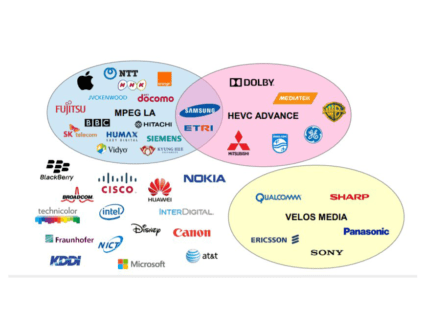Just back from ten days in Europe where I spoke at Streaming Tech Sweden and met with many streaming producers and encoding vendors. In particular, the vendors expressed dismay at the slow adoption of HEVC, particularly in view of Apple’s decision to include HEVC in HLS.
Now that we’ve confirmed that battery life won’t be an issue, adding HEVC to HLS seems like a total no-brainer. Why the delay? It’s hard to say, but clearly, the uncertainty regarding royalties isn’t helping. You can see why in the figure above which is from a talk given by Divideon’s Jonatan Samuelsson at Streaming Tech Sweden. As you can see, it shows the members of the three patent pools and those who haven’t yet joined a pool.
Regarding content royalties, MPEG-LA isn’t charging any, and HEVC Advance is charging about 18 cents per year per subscriber, which isn’t too onerous. A remarkable nine months after launching, and close to five years after HEVC shipped, Velos still hasn’t announced their royalty policy. On the lower left, you see the companies who have contributed IP to the spec but haven’t joined a pool or announced their intentions.
I feel pretty safe in saying that no one likes to buy a product (or adopt a new technology) without knowing the price. CFOs in streaming companies hate the thought, as do their legal advisors. No company wants to adopt a new technology only to learn months or years later that using it is commercially unreasonable.
As I’ve written about many times now, HEVC IP owners have dragged their feet on delivering a cohesive pricing policy. Now that Apple has made HEVC very usable, it’s time for HEVC IP owners to make it commercially practical. With the codebase for HEVC competitor AV1 set to freeze in January 2018, the clock is definitely ticking.
(Author’s note: Corrected article to show $0.18/cents per year rather than $0.018, an error noted by Jonatan Samuelsson).
 Streaming Learning Center Where Streaming Professionals Learn to Excel
Streaming Learning Center Where Streaming Professionals Learn to Excel










Jan,
Your comment is of course well taken, that it’s time for IP owners to come together to make this technology (HEVC) commercially viable by declaring (acceptable) licensing terms. It is also reasonable to assume that the current level of fragmentation between various pools and individual patent holders is an impediment to broader market acceptance. But one fact stands in its favor. All parties contributing technology to the development of HEVC were aware going in that they must be willing to offer RAND terms for their IP. Part of the assumption — which I think the courts will back up — is that if any contributing party was unwilling to do so, it was upon them to make such a declaration. Moreover, while the term RAND needs interpretation, the courts will very likely uphold and provide an interpretation, as a last resort.
So as I see it, there is now an opportunity for HEVC to become widely used, gaining momentum incrementally. And as the wagon rolls, the IP owners will figure out how to get on the wagon. As for AV1, I can see a significant streaming market for it as well, so these will likely co-exist, without one eliminating the other. But as of now, HEVC’s problems have a chance to resolve in the next 18 months or so. But I also agree, that if that doesn’t happen, the window of opportunity may close. Cheers.
Pankaj,
There are two issues that I read from your reply. First, you mention RAND, and how courts might rule. This is problem number one. That we may have to assume how courts might rule in order to determine exactly what HEVC usage might eventually cost is a problem. The IP holders are fragmenting, and it is unclear what that may mean for HEVC, and makes H266 (or whatever the next generation codec will be called) seem like a dead man walking. Second, you mention that “there is now an opportunity for HEVC to become widely used,” and then assume that “IP owners will figure out how to get on the wagon.” This is exactly backwards. We cannot know the real opportunity for HEVC until the cost issues have been resolved. The IP licensing uncertainty is a real problem, and will continue to hinder the adoption of HEVC, as it should.